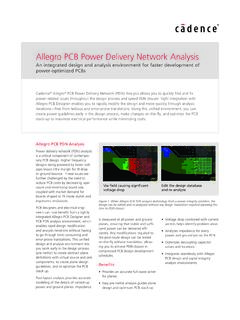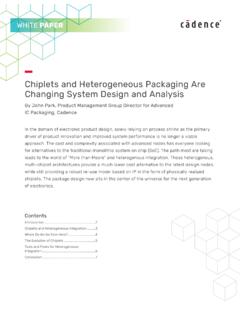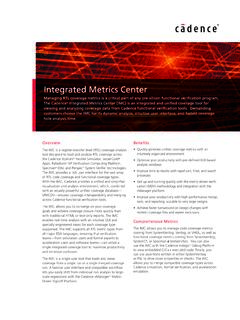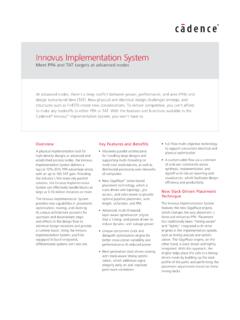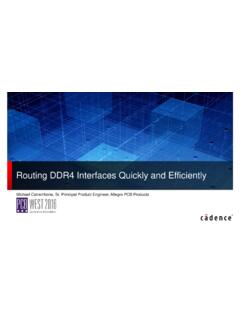Transcription of DO-254 Explained
1 IntroductionIf you re reading this paper, you are likely struggling to understand the DO-254 specification1, what this standard means, what it takes to comply, and how much more time and cost you should allocate to meet this standard. This white paper, the first in a series of white papers, will attempt to explain the standard, the concepts and reasoning behind the standard, and the basic steps and components necessary to successfully complete the project and achieve DO-254 to several industry sources, a project meeting DO-254 can cost to 4X more than the same project without DO-254 .
2 Why the extra expense? Usually the 4X cost increases come from a lack of DO-254 experience, further compounded when current methodologies and processes are significantly lacking compared to a structured flow conforming to DO-254 . In addition, a lack of adequate project planning and evidence that the overall process was followed can lead to audit failures causing design and verification re-work and additional justification headaches. However, there are ways to create a DO-254 -approved project without breaking your schedule or budget.
3 A well planned and executed DO-254 project will almost certainly take more time and money than a non- DO-254 project, but there are ways to reduce these costs to manageable levels. The first step in the process is becoming better educated in the underlying concepts and components of DO-254 . What Is DO-254 ? Simply stated, DO-254 is a requirements-driven process-oriented safety standard used on commercial electronics that go into aircraft. (Conceptually speaking, this standard applies to all electronics in anything that flies or could crash and pose a hazard to the public.)
4 DO-254 ExplainedBy CadenceThis white paper, the first in a series of DO-254 -related white papers, will explore the high-level concepts and activities within the DO-254 Design Assurance Guidance for Airborne Electronic Hardware specification, why they exist, and what they mean. In this paper, we will explore the safety-related concepts of requirements traceability, design assurance levels, the overall DO-254 -compliant flow as documented in the spec, and several other aspects that might not be well documented but are critical to project DO-254 spec is available on the RTCA website.
5 1 What Is DO-254 ? ..1 Certification Officials ..5 I Still Don t Get ..5 Other Design Considerations ..6 Conclusion ..6 For Further Information ..6 Based on their safety criticality, different parts of the aircraft are designated different Design Assurance Levels, or DALs for short (Figure 1). A system that is highly critical will receive a higher DAL, with DAL A reserved for the most critical systems. This criticality is determined by a safety assessment of the aircraft and interacting systems to determine the required target failure rate.
6 For DO-254 , the difference between meeting DAL A and DAL B is minimal, so they are frequently referred to as DAL A/B in various writings, including aspects of this AssuranceLevel (DAL)DescriptionTarget SystemFailure RateExample SystemLevel A(Catastrophic)Failure causescrash, deaths<1 x 10-9 chanceof failure/flight-hrFlight controlsLevel C(Major)Failure may causestress, injuries<1 x 10-5 chanceof failure/flight-hrBackup systemsLevel B(Hazardous)Failure may causecrash, deaths<1 x 10-7 chanceof failure/flight-hrBraking systemsLevel D(Minor)Failure may causeinconvenienceNo safety metricGround navigationsystemsLevel E(No effect)No safety effect onpassengers/crewNo safety metricPassengerentertainmentFigure 1.
7 Design Assurance Levels (DALs)Because DO-254 is a process-oriented standard, it s important to understand the overall flow, shown in Figure 2 (and in Figure 5-1 of the DO-254 specification), expected by a DO-254 certification (Section 4)Derived RequirementsDetailed DesignConceptualDesignRequirementsCaptur eImplementationProductTransitionSupporti ng ProcessesHardware DesignProcesses (Section 5)System Processes (Section 2)Manufacturing ProcessesSection Validation and verification Processes (Section 6) Configuration Management (Section 7) Processes Assurance (Section 8) Certification Liaison (Section 9)Figure 2: DO-254 flowLet s walk through this process to briefly explain each component of this is a critical piece of the DO-254 certification.
8 It s important to document your project flow up-front and approach your certification official to gain their approval early in the project. Typically the high-level plans are documented in the Plan for Hardware Aspects of Certification (PHAC commonly pronounced as pea-hack ). This plan should include all aspects of your project and how you will meet the DO-254 requirements. ExplainedRequirements Capture and ValidationThe DO-254 specification utilizes a requirements-based design and verification approach. This means that the entire hardware project revolves around a formal set of high-level requirements.
9 Before any RTL is written, each of these requirements must be written down, given a unique reference name, and reviewed for a variety of criteria including understandability, testability, verifiability, DesignAt the conceptual design stage, a larger design is broken down into smaller, more manageable components. This might be thought of as a high-level block diagram. (Note: For a sufficiently simple system, the conceptual design step may be skipped or merged with the Detailed Design step.) Detailed DesignThis step is where the real design work takes place.
10 For each component detailed in the conceptual design, the RTL hardware design should implement each and every requirement for that component. Each high-level requirement should be traced to the top-level RTL module implementing that requirement. This traceability can happen in a variety of ways, and it is up to the implementation team to determine the desired approach. Separately, the verification team should create verification tests to verify that each requirement has been met by the RTL, including a message to the log file showing the expected result, the actual result seen in the simulation, and the result (pass/fail).

